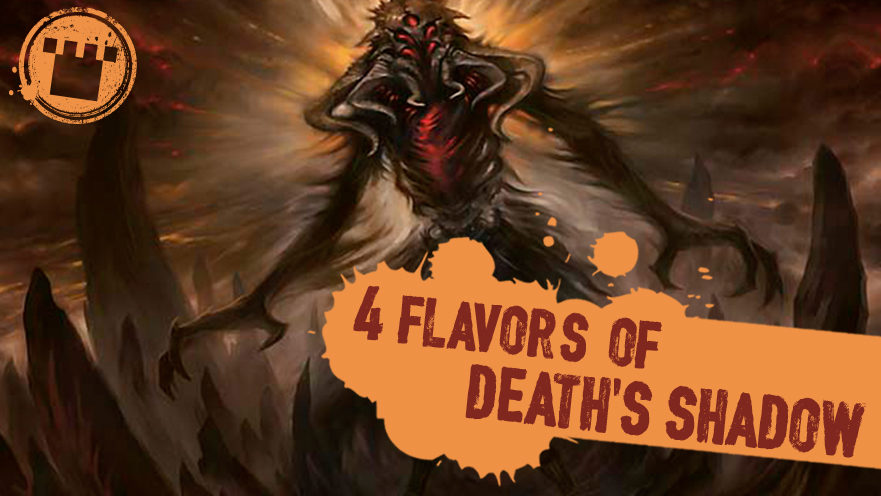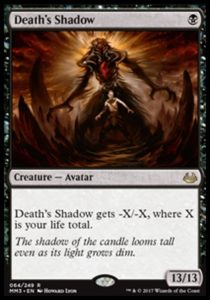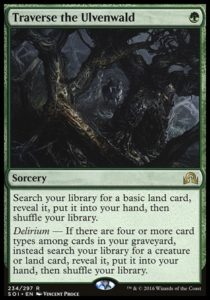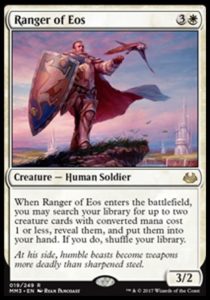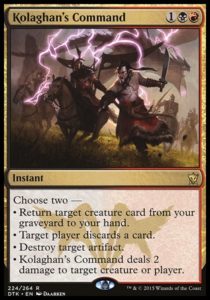Since its breakout performance at Grand Prix Vancouver in February at the hands of Josh Utter-Leyton and team, the bold new take on Death’s Shadow has quickly made a name for itself as the deck to beat in Modern. Utter-Leyton, Gerry Thompson, and Sam Black all made Top 8 with a new Death’s Shadow list that cut down on the Become Immense and Temur Battle Rage package in favor of Tarmogoyf and Traverse the Ulvenwald. Since then, the deck has continued to evolve, reacting as Modern players wrestled with its overwhelming power.
As I began to prepare for Grand Prix Vegas, I understood that I’d have to face this big bad wolf. While Death’s Shadow decks only make up about 15% of the Modern metagame, I realized that, if I wanted to be competitive at the top tables, understanding the engines that make Death’s Shadow decks tick would be key. Yes, I said “decks,” plural – as Death’s Shadow Aggro has evolved, it seems to have taken on a mind of it’s own. Abzan, Jund, Grixis, four-color and even five-color variants have been spotted in feature matches and Grand Prix Top 8’s. And beginning to understand the differences (and similarities) was my first step in understanding how to defeat them.
It’s almost unanimously agreed upon that Death’s Shadow decks are some of the most skill-intensive decks in Modern, with subtle decision trees early in the game that can lead to game wins or losses twenty turns later. The rewards skilled play, and I expect at least some of these variations to be the decks of choice for many professional players looking to take home the trophy in Vegas.
Before I dive into the differences between Death’s Shadow builds, it’s important to highlight their similarities. Besides sharing a signature card, all variations run the full suite of hand disruption: four Thoughtseize and four Inquisition of Kozilek. They also all run the full four Street Wraith, a great cycler that helps you manage your life total while drawing into threats. Street Wraith also often functions as a pseudo “mirror-breaker” – cast it in the late game, and it can swamp-walk in for damage while dodging Fatal Push.
Jund
Current Jund Death’s Shadow lists hearken back to Utter-Leyton’s Grand Prix Vancouver-winning deck. They use cyclers like Mishra’s Bauble and Street Wraith to enable delirium for Traverse the Ulvenwald, and they usually contain one or two copies of Temur Battle Rage. They also have access to the full range of typical Jund removal, such as Kolaghan’s Command and Abrupt Decay.
Niklas Holtmann, 15th place Grand Prix Copenhagen, May 27-28, 2017
Creatures
4 Death’s Shadow
4 Tarmogoyf
1 Ghor-Clan Rampager
4 Street Wraith
Spells
2 Liliana of the Veil
3 Fatal Push
4 Inquisition of Kozilek
2 Tarfire
4 Thoughtseize
4 Traverse the Ulvenwald
2 Abrupt Decay
2 Temur Battle Rage
2 Kolaghan’s Command
4 Mishra’s Bauble
Lands
1 Blood Crypt
4 Bloodstained Mire
1 Forest
1 Godless Shrine
1 Marsh Flats
1 Overgrown Tomb
1 Polluted Delta
1 Stomping Ground
1 Swamp
4 Verdant Catacombs
2 Wooded Foothills
Sideboard
2 Nihil Spellbomb
1 Surgical Extraction
1 Ancient Grudge
1 Kataki, War’s Wage
1 Orzhov Charm
1 Anger of the Gods
1 Fulminator Mage
1 Kozilek’s Return
1 Liliana, the Last Hope
3 Lingering Souls
1 Maelstrom Pulse
1 Ranger of Eos
It’s important to note that even in a “Jund” list like the one above, it’s easy to throw in a one-of Godless Shrine and unlock toolbox cards in the board such as Kataki, War’s Rage and Ranger of Eos. Another card that has proven incredibly powerful against most flavors of Death’s Shadow is Lingering Souls. Souls provides up to four bodies that can act as great chump blockers for an opposing Death’s Shadow or Tarmogoyf, and they can even fly over your opponents threats if necessary.
Abzan
Death’s Shadow’s rising popularity has brought plenty of large threats into the Modern scene, making cards such as Tarfire and Lightning Bolt increasingly poorly positioned. Proponents of Abzan Death’s Shadow argue that there is little to no need to play red anymore, but still want to keep the Traverse the Ulvenwald package to utilize a toolbox of one-of sideboard cards. A heavier white splash also gives you access to a variety of sideboard hate that you can tune to the expected metagame. The ability to tutor up two Death’s Shadows with Ranger of Eos (and to tutor up your Ranger with Traverse) has made it a popular maindeck and sideboard inclusion as well.
Lucas Beach, 2nd place SCG Modern IQ Columbia, April 9, 2017
Creatures
4 Death’s Shadow
2 Grim Flayer
4 Tarmogoyf
4 Street Wraith
Spells
4 Liliana of the Veil
4 Fatal Push
4 Inquisition of Kozilek
4 Thoughtseize
4 Traverse the Ulvenwald
3 Abrupt Decay
1 Dismember
4 Mishra’s Bauble
Lands
1 Forest
1 Godless Shrine
4 Marsh Flats
2 Overgrown Tomb
1 Swamp
1 Temple Garden
4 Verdant Catacombs
4 Windswept Heath
Sideboard
1 Grafdigger’s Cage
3 Collective Brutality
1 Scavenging Ooze
2 Stony Silence
3 Fulminator Mage
3 Lingering Souls
1 Maelstrom Pulse
1 Ranger of Eos
Five-Color
Five-color Death’s Shadow has recently become the most popular of its ilk that still utilizes the delirium/Traverse the Ulvenwald package. The ability to fetch for nearly perfect mana gives you access to white threats such as Ranger of Eos and Lingering Souls, the ability to blow your opponents out with Temur Battle Rage, and the utility of cards like Terminate and Kolaghan’s Command. The Watery Grave in the board enables you to play Death’s Shadow’s best counterspell, Stubborn Denial, which acts as a one-mana Negate when your Death’s Shadow is a 4/4 or bigger.
Márcio Carvalho, 10th Place Grand Prix Copenhagen, May 27 – 28, 2017
Creatures
4 Death’s Shadow
4 Tarmogoyf
1 Ranger of Eos
4 Street Wraith
Spells
2 Liliana of the Veil
1 Liliana, the Last Hope
4 Fatal Push
4 Inquisition of Kozilek
4 Thoughtseize
4 Traverse the Ulvenwald
2 Abrupt Decay
2 Temur Battle Rage
2 Terminate
4 Mishra’s Bauble
Lands
1 Blood Crypt
4 Bloodstained Mire
1 Godless Shrine
4 Marsh Flats
2 Overgrown Tomb
1 Stomping Ground
1 Swamp
4 Verdant Catacombs
Sideboard
1 Watery Grave
2 Grafdigger’s Cage
3 Stubborn Denial
1 Ancient Grudge
2 Collective Brutality
2 Kozilek’s Return
4 Lingering Souls
Grixis
Grixis is the deck that deviates the most from traditional Death’s Shadow builds, forgoing Traverse the Ulvenwald, Tarmogoyf, and delirium-enablers for Tasigur, Snapcaster Mage, and main-deck Stubborn Denial. Grixis has recently become the most popular build among competitive players, and it was the only version of the deck to make Day 2 of last weekend’s SCG Modern Open.
Andrew Jessup, 4th Place SCG Modern Open Charlotte, June 10-11, 2017
Creatures
4 Death’s Shadow
4 Snapcaster Mage
4 Street Wraith
2 Tasigur, the Golden Fang
2 Gurmag Angler
Spells
4 Fatal Push
2 Inquisition of Kozilek
4 Serum Visions
3 Stubborn Denial
4 Thought Scour
4 Thoughtseize
2 Terminate
2 Kolaghan’s Command
Lands
2 Blood Crypt
4 Bloodstained Mire
1 Island
4 Polluted Delta
4 Scalding Tarn
1 Steam Vents
1 Swamp
2 Watery Grave
Sideboard
1 Engineered Explosives
2 Ceremonious Rejection
2 Nihil Spellbomb
1 Stubborn Denial
2 Surgical Extraction
3 Collective Brutality
1 Dreadbore
1 Anger of the Gods
2 Liliana, the Last Hope
With no need to turn on delirium, we can replace “dead” cards such as Mishra’s Bauble with effective card engines such as Serum Visions. We can also run fewer main-deck Planeswalkers and more cards like Thought Scour to turn on our delve creatures. These decks tend to have finely-tuned sideboards, with cards like Ceremonious Rejection to take on Eldrazi Tron decks, and Anger of the Gods and Collective Brutality to help face the increasingly popular Abzan Counters Company lists.
Of the many (many) flavors of Death’s Shadow, Grixis is the one I expect to face the most this coming weekend. However, knowing how each deck functions – whether it’s by turning on delirium or locking down the board with counter spells after resolving a threat – is the first step to successfully defeating this popular archetype. I have been tuning my deck and sideboard for the match-up, and I expect many of the players preparing to battle in Vegas will be doing the same. Will our preparation work? There’s only one way to find out.
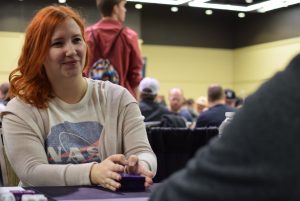
A Spike at heart, Chantelle spends her free time prepping for tournaments, working toward the ever-elusive Mythic Championship, and championing other competitive ladies. She’s a combo aficionado and seasoned aggro deck player, and Standard and Modern are her preferred formats. Growing and improving as a player, both technically and in her mental game, are of the utmost importance to her.

